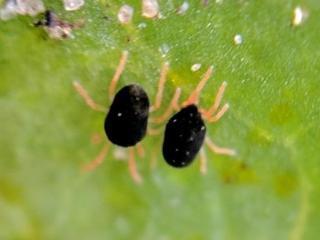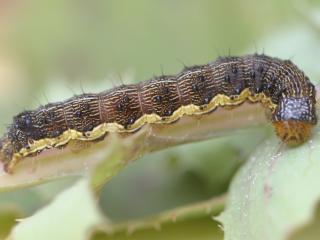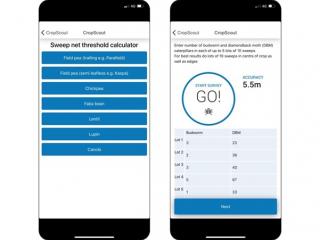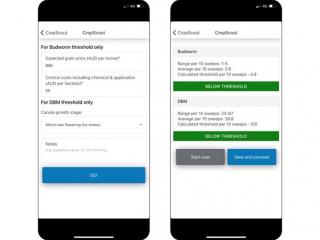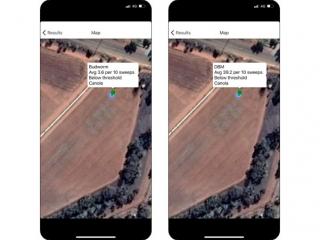Spring control of redlegged earth mites
Spring has sprung and growers and consultants are reminded to monitor for redlegged earth mites (RLEM) in pastures and to find out their specific Timerite® spring spray date if spraying is necessary.
The timing of the sprays is based on a short window of the season when RLEM have stopped laying winter eggs (eggs that must hatch this season) and before they start laying diapause eggs (over-summering eggs able to survive until next autumn).
Controlling mites at this time means that the whole population can be reduced, leaving few mites to carry-over to the following autumn.
Growers who have not already obtained their spray date that is specific to their locality can do so (free of charge) from the Australian Wool Innovation (AWI) Limited Helpline on 1800 070 099 or you can type the latitude and longitude of your property into the AWI TIMERITE® page to obtain your spray date and other useful information.
Please note that the Timerite® date does not work against blue oat mite nor lucerne flea.
Studies by CSIRO have shown that spraying up to two weeks earlier or on the optimum spray date provides effective control of RLEM, however if spraying is delayed by two weeks after the optimum date the carry-over RLEM population into next autumn is much higher.
Farmers intending to spray paddocks should make the most of suitable weather conditions to go early or on time, rather than later than the predicted Timerite® date.
Growers are advised to spray only if they need to and to rotate chemical groups to stop resistance developing in RLEM. Repeated use of synthetic pyrethroid insecticides or organophosphate insecticides such as omethoate and chlorpyrifos provides strong selection pressure for RLEM to develop resistance.
For more information on applying integrated pest management strategies when managing RLEM refer to GRDC’s Resistance management strategy for the redlegged earth mite in Australian grains and pastures fact sheet.
Growers who find RLEM that survive registered rates of insecticide treatments are encouraged to arrange for resistance testing to be conducted by contacting DPIRD entomologist Svetlana Micic, Albany on +61 (0)8 9892 8591 or 0427 772 051. The free-of-charge service, made possible with investment by the Grains Research and Development Corporation (GRDC), is led by The University of Melbourne, in collaboration with DPIRD, Cesar Australia and CSIRO.
Grazing reduces mite carryover in pastures
The level of grazing and quantity of pasture feed on offer (FOO) is directly related to the numbers of RLEM. Department grazing trials have shown that pasture grazed to 1.4t/ha FOO during spring will have low levels of mites, equivalent to numbers after spraying pastures with high FOO level.
Spraying of pastures in spring will have little or no benefit where pasture FOO levels are kept low by grazing. Insecticides applied to control RLEM in spring pastures or legume break crops with FOO levels greater than 3t/ha will reduce their numbers and provide benefits by allowing increased spring growth and seed set and a much reduced potential for RLEM carry-over into next autumn.
However, increased production benefits can largely be wasted unless the increased feed is utilised by strategic grazing management or fodder conservation. It is recommended that farmers should not spray all pasture paddocks but rather select paddocks for spring spraying based on FOO levels, future grazing feed management, level of required seed production and intended paddock use next autumn.
Redlegged earth mite survey
Cesar Australia is conducting a national survey on redlegged earth mite. Your responses will help to increase understanding of current control strategies and to improve how the redlegged earth mite is managed across Australia. It only takes 10 minutes to complete the survey.
To thank you for your time, all survey participants will be given early access to module one of Cesar Australia’s redlegged earth mite online training which covers identification, distribution, host range and damage.
The survey is being led by Cesar Australia as part of a GRDC investment (CES2010-001RTX), which has been extended to red meat producers through co- investment from Meat and Livestock Australia and to pasture seed producers through co-investment from AgriFutures Pasture Seeds Program (PRJ-013101). The wider project involves contributions from the Department of Primary Industries and Regional Development (DPIRD), the University of Melbourne, and CSIRO.
If you have any questions, please contact Senior extension scientist Dr Lizzy Lowe from Cesar Australia on +61 (0)3 9349 4723 or +61 (0)484 310 697.
For more information on RLEM refer to the department’s Diagnosing redlegged earth mite page.
For more information contact Research Scientist Svetlana Micic, Albany on +61 (0)8 9892 8591 or Technical Officer Alan Lord, South Perth on +61 (0)8 9368 3758.
Article author(s): Cindy Webster (DPIRD Narrogin), Dusty Severtson (DPIRD Northam) and Alan Lord (DPIRD South Perth).
Native budworm
Caterpillar activity
- Yuna
- Eurardy
- Yandanooka
- Wittenoom Hills
Technical officer Dave Nicholson (DPIRD) reports finding 26 native budworm caterpillars (19-38mm in length) per 10 sweeps in a podding lupin crop near Yuna. Some of the caterpillars were beginning to enter the lupin pods and chew on the developing seed.
Native budworm caterpillars (one per 10 sweeps) have also been reported in a lupin crop at Eurardy.
Native budworm caterpillars (two per 10 sweeps) were found in canola crops at Yandanooka and Wittenoom Hills.
The feeding behaviour of native budworm caterpillars changes according to the type of crop the caterpillars are feeding upon. Field pea, chickpea, lentil and faba bean crops are very susceptible to all sizes of caterpillars during the formation and development of pods. Tiny caterpillars can enter developing pods and damage seed or devour the entire contents of the pod.
Narrow-leafed lupin pods and seeds will not be damaged by native budworm until they are close to maturity and the pods are losing their green colouration. Pod walls are not penetrated until the caterpillars are over 15mm in length. The decision to spray a lupin crop should not be made until caterpillars are greater than 15mm in length and the pods are losing their green colour. At this stage it is difficult to use a sweep net as the lupin plants are stiff and the pods are spiky. An alternative to sweeping is to cut plants from several places in the crop and shake them into a bin to count caterpillar numbers. Taking small areas from the crop, say a quarter or a tenth of a square metre, or a number of plants equal to that found in a square metre, is the easiest method for assessing damage levels for the entire crop.
Canola is similar to narrow-leafed lupin in that canola pods only become attractive to caterpillars as the crop nears maturity and begins to hay-off. Caterpillars of all sizes will enter pods at this stage, with larger caterpillars doing the most damage. Native budworm can also cause damage after a canola crop has been swathed. This will occur if the crop is swathed when many pods are still green with soft seed. Seed damage from native budworm increases in swathed crops if drying is prolonged due to cool damp conditions.
Native budworm moth trapping surveillance
- Usual automated and manual trapping locations
The larger native budworm flights recorded by budworm trappers this week include: Southern Cross (157 moths), Wyalkatchem (113), Dowerin (101), Grass Patch (97), Kellerberrin (92), Northampton (78), Dalwallinu (71), Cunderdin (19) and Badgingarra (16).
Results of this week's manual trappings are available at the department’s Native budworm moth numbers 2021.
A mapped view of the native budworm trap captures is available at Cesar Australia’s MothTrapVisWA page. Viewers need to select the desired trapping date range.
Pesticide options for the control of native budworm can be found in DPIRD’s 2021 winter spring insecticide guide.
Detailed information on this pest can be found at DPIRD’s Management and economic thresholds for native budworm page or listened to on the recently published Native budworm podcast.
For more information contact Technical Officer Alan Lord, South Perth +61 (0)8 9368 3758 or +61 (0)409 689 468.
Article author: Alan Lord (DPIRD South Perth).
DPIRD’s CropScout app has new sweep net module
The DPIRD MyPestGuide CropScout application is designed to assist growers, consultants and other field technicians apply spray thresholds for pests in crops.
An upgraded version of this app can now be downloaded for free from Android and iOS stores. The app has a new module that allows users to enter numbers of native budworm, diamondback moth (DBM), and pea weevil sweep netted in pulse and canola crops in winter/spring and the app calculates whether numbers are above or below spray thresholds.
Native budworm spray thresholds vary by crop type and also by anticipated grain price and cost of control.
DBM thresholds vary by plant growth stage and plant stress levels. These calculations are run in the background of the app and each survey result is displayed relative to the calculated threshold.
Once sweep net results are saved, they can be viewed on a map on your mobile phone when you are in mobile range. All other app functionality can be performed out of mobile range, including data entry and capturing the GPS location. Results can be synced with your personal CropScout account and viewed online at the MyPestGuide CropScout page.
Results can also be exported and shared via .csv file as a spreadsheet of results with GPS, or as a .kml file, and viewed on Google Earth or Google Maps.
The MyPestGuide CropScout app was first published in 2018 and has been funded by DPIRD’s Boosting Grains R&D programs. The app started with a “Canola aphid” module which allows users to indicate canola aphids on individual plants and runs the sequential sampling algorithms to optimise the effort required when monitoring crops at a set level of accuracy. Another module, in addition to the latest sweep net module, will be added in the future to assess whether surveyed oat aphids, corn aphids and Russian wheat aphid numbers are above or below established spray thresholds.
The CropScout team is keen to hear feedback from CropScout app users to ensure it is user friendly and is providing decision support for growers, agronomists and field technicians. If you have any comments or suggestions, please email cropscout@dpird.wa.gov.au.
More information on the CropScout app can be found on DPIRD’s CropScout app page.
For more information contact Research Scientist Dustin Severtson, Northam on +61 (0)8 9690 2160.
Article author: Dustin Severtson (DPIRD Northam).
Listen to DPIRD’s new crop protection podcasts
DPIRD has started a podcast series that focusses on areas of crop protection research. The first two podcasts ‘Managing sclerotinia’ and ‘Native budworm’ are now live online.
In the ‘Managing sclerotinia’ podcast research agronomist Janette Pratt (DPIRD) discusses the fungal disease sclerotinia stem rot and the SclerotiniaCM app with plant pathologist Ciara Beard (DPIRD).
In the ‘Native budworm’ podcast research agronomist Cindy Webster (DPIRD) interviews technical officer Alan Lord (DPIRD) about the destructive pest native budworm and the surveillance program that Alan leads in WA each season.
To listen to these podcasts visit the Grower Group Alliance Grains podcast page.
For more information on these podcasts contact Research agronomists Cindy Webster, Narrogin on +61 (0)8 9881 0201 or Janette Pratt, Moora on +61 (0)8 9651 0531.
Article author: Cindy Webster (DPIRD Narrogin).

